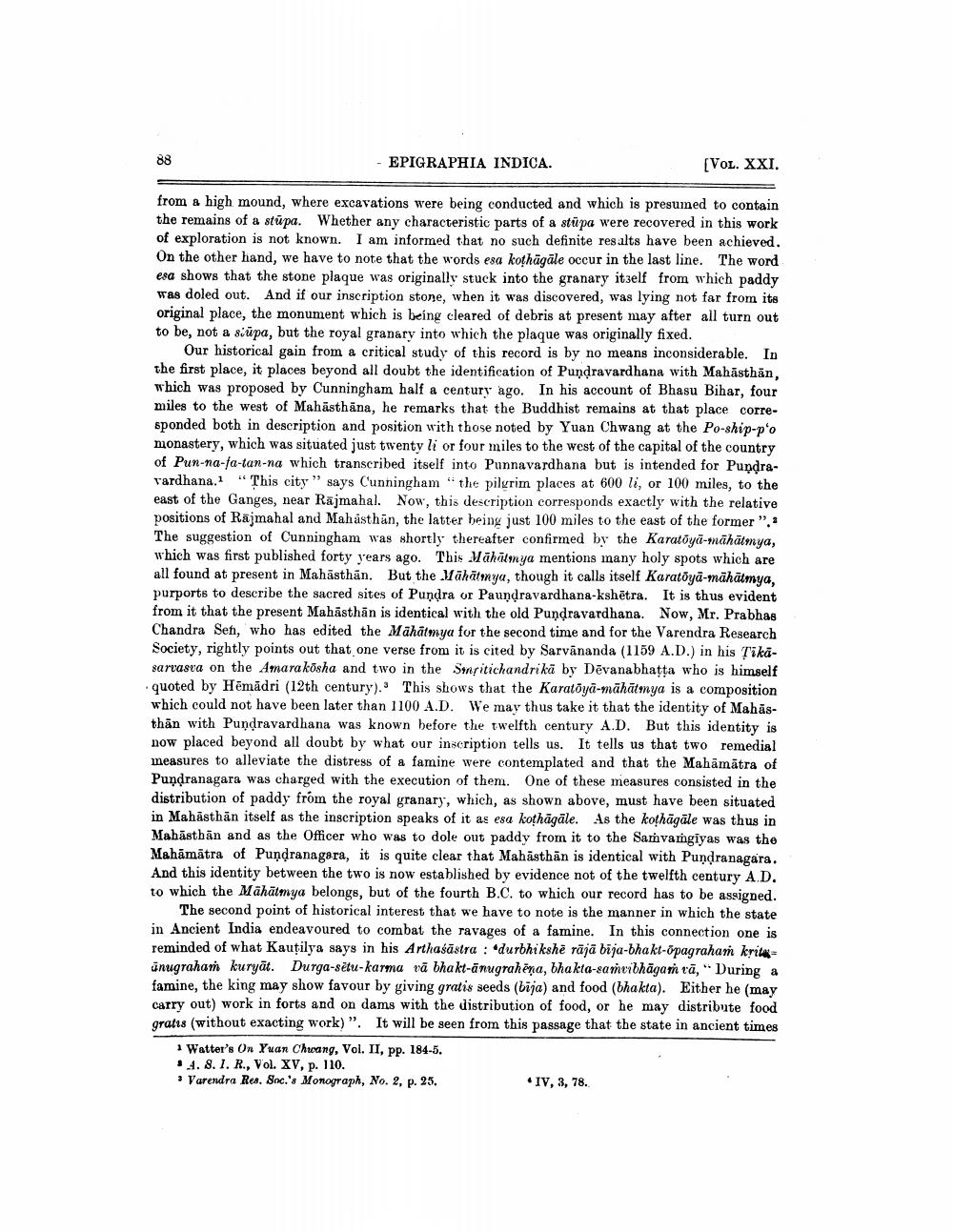________________
38
- EPIGRAPHIA INDICA.
[VOL. XXI.
from a high mound, where excavations were being conducted and which is presumed to contain the remains of a stūpa. Whether any characteristic parts of a stupa were recovered in this work of exploration is not known. I am informed that no such definite resalts have been achieved. On the other hand, we have to note that the words esa kothāgāle occur in the last line. The word esa shows that the stone plaque was originally stuck into the granary itself from which paddy was doled out. And if our inscription stone, when it was discovered, was lying not far from its original place, the monument which is being cleared of debris at present may after all turn out to be, not a siūpa, but the royal granary into which the plaque was originally fixed.
Our historical gain from a critical study of this record is by no means inconsiderable. In the first place, it places beyond all doubt the identification of Pundravardhana with Mahāsthān, which was proposed by Cunningham half a century ago. In his account of Bhasu Bihar, four miles to the west of Mahāsthāna, he remarks that the Buddhist remains at that place corresponded both in description and position with those noted by Yuan Chwang at the Po-ship-p'o monastery, which was situated just twenty li or four miles to the west of the capital of the country of Pun-na-fa-tan-na which transcribed itself into Punnavardhana but is intended for Pundravardhana. "This city” says Cunningham "the pilgrim places at 600 li, or 100 miles, to the east of the Ganges, near Rajmahal. Now, this description corresponds exactly with the relative positions of Rajmahal and Mahästhān, the latter being just 100 miles to the east of the former".. The suggestion of Cunningham was shortly thereafter confirmed by the Karatoya-māhātmya, which was first published forty years ago. This Māhātmya mentions many holy spots which are all found at present in Mahāsthān. But the Māhātmya, though it calls itself Karatoyā-māhātmya, purports to describe the sacred sites of Pundra or Paundravardhana-kshētra. It is thus evident from it that the present Mahāsthān is identical with the old Pundravardhana. Now, Mr. Prabhas Chandra Sen, who has edited the Māhātmya for the second time and for the Varendra Research Society, rightly points out that one verse from it is cited by Sarvānanda (1159 A.D.) in his Țikāsarvasva on the Amara kösha and two in the Smritichandrika by Devanabhatta who is himself quoted by Hēmādri (12th century). This shows that the Karatāyā-māhātmya is a composition which could not have been later than 1100 A.D. We may thus take it that the identity of Mahāsthan with Pundravardhana was known before the twelfth century A.D. But this identity is now placed beyond all doubt by what our inscription tells us. It tells us that two remedial measures to alleviate the distress of a famine were contemplated and that the Mahāmātra of Pundranagara was charged with the execution of them. One of these measures consisted in the distribution of paddy from the royal granary, which, as shown above, must have been situated in Mahāsthān itself as the inscription speaks of it as esa kothāgāle. As the kothāgāle was thus in Mahästhān and as the Officer who was to dole out paddy from it to the Samvamgiyas was the Mahāmātra of Pundranagara, it is quite clear that Mahästhān is identical with Pundranagara. And this identity between the two is now established by evidence not of the twelfth century A.D. to which the Mähätmya belongs, but of the fourth B.C. to which our record has to be assigned.
The second point of historical interest that we have to note is the manner in which the state in Ancient India endeavoured to combat the ravages of a famine. In this connection one is reminded of what Kautilya says in his Arthaśāstra : 'durbhikshē rājā bija-bhakt-opagraham krita ūnugrahań kuryāt. Durga-sētu-karma rā bhakt-anugrahēna, bhakta-samvibhāgam rā," During a famine, the king may show favour by giving gratis seeds (bija) and food (bhakta). Either he (may carry out) work in forts and on dams with the distribution of food, or he may distribute food gratis (without exacting work)". It will be seen from this passage that the state in ancient times
1 Watter's On Yuan Chuang, Vol. II, pp. 184-5. 14.8.1. R., Vol. XV, p. 110. • Varendra Res. Soc.'s Monograph, No. 2, p. 25.
• IV, 3, 78.




